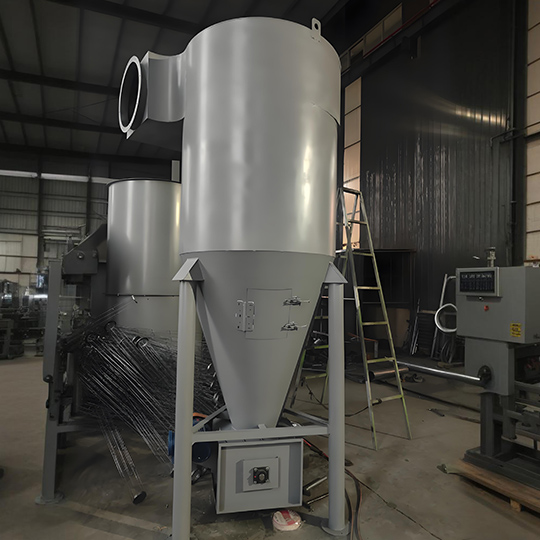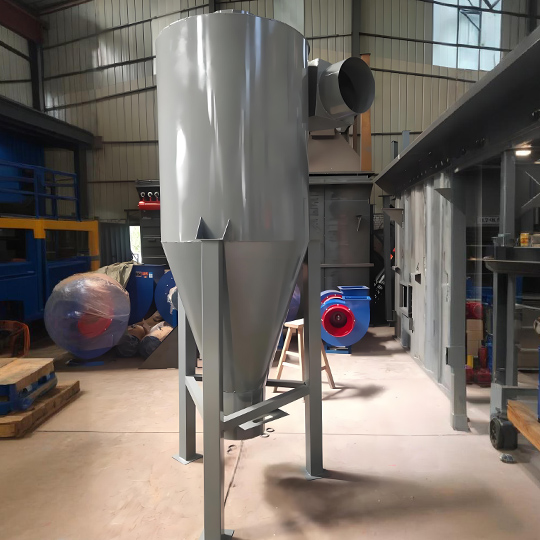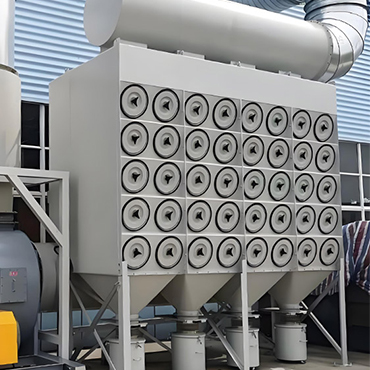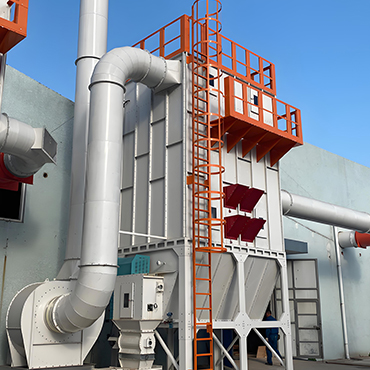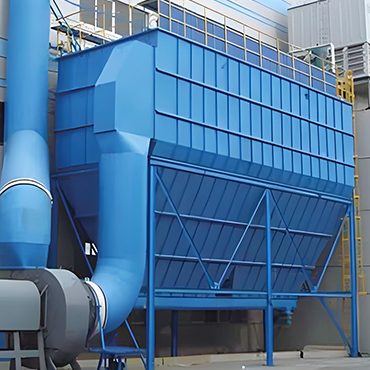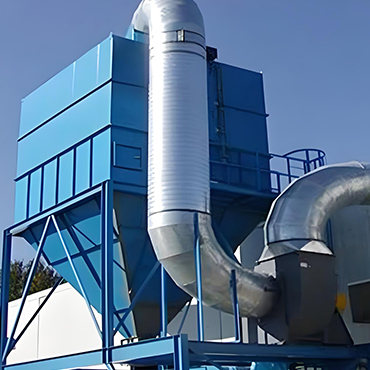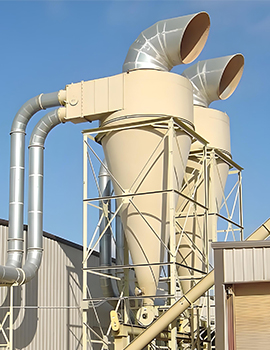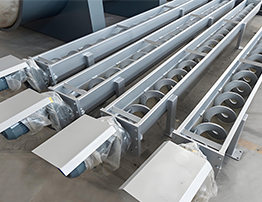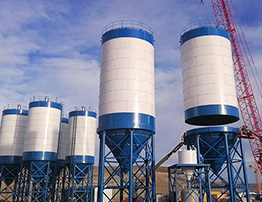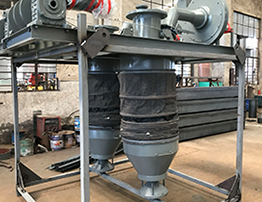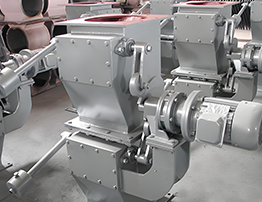Cyclone Dust Collector
A cyclone dust collector is a type of dust removal device. It consists of an inlet pipe, an outlet pipe, a cylindrical body, a conical body, and a hopper. The dust removal mechanism involves forcing the dust-laden airflow into a rotational motion, where centrifugal force separates and captures dust particles on the inner wall. The particles then fall into the hopper under the influence of gravity.
- Simple Structure
- Robust and Durable
- Easy Maintenance
- Low Energy Consumption
- Effective Pre-Dedusting
Industry-Leading Cyclone Dust Collector Manufacturer
As a leading manufacturer of cyclone dust collectors, DARKO provides over 10 years of specialized expertise in industrial dust control. Our ISO-certified systems, exported to more than 30 countries, deliver robust and cost-effective dust removal solutions for industries such as cement, metallurgy, chemical, and lithium battery production. Combining high-efficiency separation with durable, low-maintenance operation, DARKO cyclone collectors are engineered for reliability in the most demanding environments.
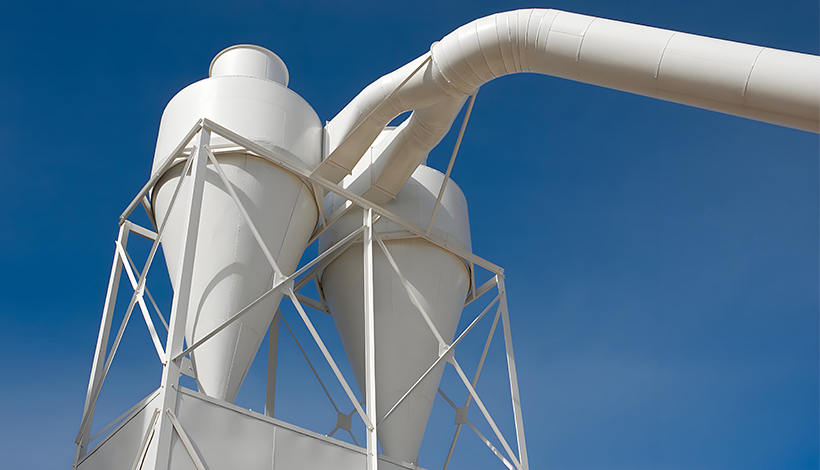
High-Efficiency Dust Collection Solutions
High-efficiency pleated filters (99.97%) for welding fumes, pharmaceutical dust, and fine particulates. Compact design with easy maintenance.
High-efficiency filter bags (99.9%+) for cement, metallurgy and heavy dust loads. Robust construction with easy bag replacement.
ATEX-certified design with integrated venting and isolation for combustible dust (e.g., aluminum, chemical powders). Essential for safe operation in hazardous areas.
Long filter bags for high-efficiency industrial dust control.
99.9% efficient offline cleaning for high-density industrial dust.
Online cleaning, 99.9% efficiency for cement & wood dust control.
- Technical Specification
- Basic Structure
- Core Performance
| Model | Flow (m³/h) | 12m/s | 15m/s | 18m/s | X-Type Loss | Y-Type Loss | Dimensions (Φ×L) | X-Wt | Y-Wt |
|---|---|---|---|---|---|---|---|---|---|
| YX-5.5 | 1000-1500 | 1000 | 1200 | 1500 | 44-99 | 49-111 | Φ552×950 | 94 | 84 |
| YX-7.5 | 2000-3000 | 2000 | 2500 | 3000 | – | – | Φ762×1360 | 161 | 145 |
| YX-9.6 | 3000-4500 | 3000 | 3800 | 4500 | – | – | Φ996×1640 | 262 | 235 |
| YX-11 | 4000-6000 | 4000 | 5000 | 6000 | – | – | Φ1110×1880 | 341 | 310 |
| YX-12 | 4900-7300 | 4900 | 6100 | 7300 | – | – | Φ1230×2090 | 416 | 376 |
| YX-13 | 5700-8600 | 5700 | 7100 | 8600 | – | – | Φ1330×2225 | 497 | 447 |
| YX-14 | 6700-10100 | 6700 | 8400 | 10100 | – | – | Φ1445×2420 | 568 | 512 |
| YX-15 | 8300-12500 | 8300 | 10400 | 12500 | – | – | Φ1599×2685 | 697 | 617 |
| YX-16 | 10000-15200 | 10000 | 12600 | 15200 | – | – | Φ1765×2950 | 840 | 765 |
| YX-17 | 11500-17200 | 11500 | 15200 | 17200 | – | – | Φ1890×3165 | 989 | 903 |
The cyclone dust collector consists of five core components: an inlet pipe, exhaust pipe, cylindrical body, conical hopper, and dust collection chamber. Characterized by its simple structure, this system offers significant advantages in manufacturability, installation, and maintenance, with relatively low capital and operational costs. It has become widely adopted for separating solid/liquid particles from gas streams or solid particles from liquids.
-
Generates centrifugal forces 5-2500 times greater than gravity, enabling significantly higher efficiency than gravity settling chambers
-
Achieves >90% collection efficiency for particles above 5μm in standard configurations
-
Multi-cyclone arrays can capture 80-85% of 3μm particles
-
Operates effectively under extreme conditions (1000°C, 500×10⁵Pa) when constructed with specialized alloys/ceramics
-
Maintains 500-2000Pa pressure drop (optimized for medium-efficiency applications)
Cyclone Dust Collector Working Principle
Cyclone dust collectors separate particles via centrifugal force (5-2500× gravity) generated by high-speed tangential airflow – flinging dust toward the walls for collection while clean gas exits vertically, achieving >90% efficiency for 5μm+ particles.

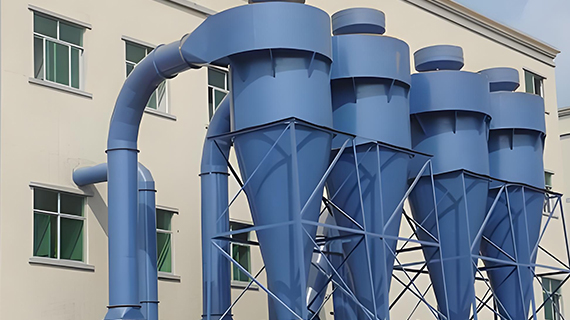
Advantages of Cyclone Dust Collectors
Cyclone dust collectors offer multiple benefits, including a simple structure, low cost, and easy maintenance. They operate without filter media, reducing running costs, and can handle high-temperature (up to 400°C) and high-concentration dust. With strong corrosion resistance, they suit various industrial environments. Their moderate pressure drop (500-2000 Pa) can be further optimized with resistance-reducing rods. They efficiently capture particles above 5μm (80%-95% efficiency) and can be specially designed for 3μm particles. Compact in size, they fit space-constrained applications. As dry separation systems, they prevent wastewater pollution and are widely used in cement, metallurgy, power generation, and other industries.
Structural Features of the Cyclone Dust Collector
-
Straight-through side chamber: Effectively eliminates the “upper ash ring” phenomenon, preventing clogging.
-
Cylinder-like cone structure: Minimizes the formation of a “lower ash ring,” avoiding the rebound of coarse dust particles in high-wear areas. This enhances service life and dust collection efficiency.
-
Optimized cyclone design: Effectively prevents secondary dust re-entrainment (dust re-scattering).

Related Products
Cyclone Dust Collectors: Types and Applications
Cyclone dust collectors feature a simple structure, low cost, and easy installation/maintenance. They are ideal for capturing large, dry, non-fibrous dust particles and widely used in metallurgy, foundry, sandblasting, building materials, and refractory industries. Available in single-tube, double-tube, and multi-tube configurations, they can be tailored to different air volume requirements.
Darko’s Industrial Cyclone Solutions
We offer various cyclone dust collectors to meet diverse process needs:
-
By Structure
-
Single Cyclone: Basic design for small-scale dust collection
-
Multi-stage Cyclone: Multiple units for enhanced large-scale processing
-
-
By Airflow Direction
-
Axial-flow: Higher efficiency with axial airflow
-
Cross-flow: Specialized for specific particle types
-
-
By Efficiency
-
High-efficiency: For fine particle capture
-
Standard: For larger particles
-
-
By Inlet Design
-
Side-inlet: For specialized processes
-
Top-inlet: For specific applications
-
-
By Industry Application
-
Cement production
-
Metallurgy & foundry
-
Chemical/pharmaceutical processes
-
-
By Gas Temperature
-
High-temperature (up to 400°C)
-
Standard temperature
-
For technical consultation or product selection, please contact our sales team for professional support.
-
Pros: Simple structure, low maintenance, no moving parts, handles high temperatures/pressure.
-
Cons: Low efficiency for fine particles (<5μm); often needs a secondary filter (e.g., baghouse).
Key parameters:
-
Cylinder diameter (D), inlet dimensions (width × height), exhaust pipe diameter (0.5D), cone angle (10°–20°).
-
Use standard models (Lapple/Stairmand) or CFD simulations.
Yes, but use heat-resistant materials (e.g., stainless steel or refractory-lined carbon steel). Typically handles up to 400°C+, outperforming baghouses.





